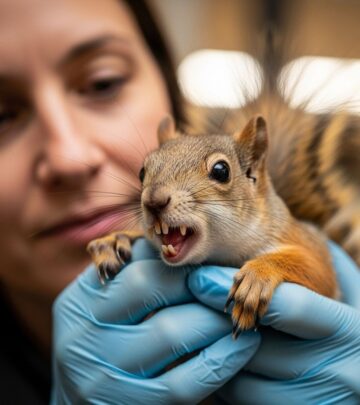Can Humans Get Fleas? Key Facts On Bites, Risks & Prevention
Fleas bother pets and bite people — learn why they don’t stay on humans and how to protect your home.

Image: HearthJunction Design Team
Can Humans Get Fleas?
Fleas are a common concern for pets and their owners, known for their irritating bites and potential to spread throughout a household. But what about people? Can humans actually get fleas, or are we just innocent bystanders in the battle against these pests? Below, we explore the truth about fleas and their interaction with humans, dive into the risks, symptoms, and effective prevention methods, and answer frequently asked questions for pet parents and anyone fighting a flea problem.
What Are Fleas?
Fleas are tiny, wingless insects belonging to the order Siphonaptera. Known for their remarkable jumping abilities, fleas are external parasites that survive by feeding on the blood of mammals and birds. With over 2,500 species globally, these insects are notorious for infesting a wide variety of animals, and occasionally bothering humans as well.
- Adult fleas are typically less than 1/8 inch long.
- They have flattened bodies adapted for moving through fur or feathers.
- Their powerful legs allow them to leap up to 150 times their body length.
- Fleas can lay hundreds of eggs in their lifetime, making infestations hard to control once established.
Can People Get Fleas from Pets?
It is possible for humans to be bitten by fleas, especially if their pet is currently infested. Common pet fleas—such as the cat flea (Ctenocephalides felis) and dog flea (Ctenocephalides canis)—readily jump from pets onto humans, especially in environments with heavy infestations.
However, there’s an important distinction between being bitten and actually hosting fleas:
- Fleas may bite humans if animals are unavailable or if their population is high.
- However, fleas do not live or reproduce on human bodies. Our bodies do not provide the ideal environment that fleas need (such as dense fur and the right body temperature), so they rarely linger for long.
While people may find fleas briefly on their skin or clothing—especially near infested pets or in areas where pets sleep—the insects usually jump off quickly in search of a better host.
Why Don’t Fleas Live on Humans?
Humans cannot host fleas in the way that pets can. The reasons for this include:
- Lack of Fur: Fleas prefer animals with thick fur, which provides both warmth and cover. Human skin is too exposed and lacks dense hair, making it hard for fleas to hide and lay eggs.
- Host Preference: Most common flea species, like the cat and dog fleas, are adapted to feed and reproduce on specific animal hosts (primarily cats and dogs).
- Feeding Needs: Fleas require frequent blood meals and a stable environment, which our bodies do not provide.
As a result, while humans may experience flea bites, it is extremely uncommon and unsustainable for fleas to make a home on our bodies.
Types of Fleas That Can Affect Humans
Although pet fleas are the usual culprit for bites in the home, other flea species can affect humans under certain conditions:
- Cat Flea (Ctenocephalides felis): The most widespread flea on both cats and dogs, and the most likely to bite humans living with infested pets.
- Dog Flea (Ctenocephalides canis): Similar to the cat flea but less common in the U.S., this species also bites humans when its preferred hosts are unavailable.
- Oriental Rat Flea (Xenopsylla cheopis): Infamous for transmitting the plague, this flea bites both rats and humans and is a significant vector of disease worldwide.
- Chigoe Flea/Sand Flea (Tunga penetrans): Found in tropical and subtropical regions, this flea can burrow into human skin (usually feet) and cause intense irritation and infection.
Signs of Flea Bites on Humans
Flea bites on humans usually show up as small, itchy, red bumps—often grouped together or in a line. They tend to appear on the lower legs, ankles, or feet, but can occur anywhere skin is exposed. Typical symptoms include:
- Itching and irritation at the bite site
- A red halo or central puncture mark
- Rash or clusters of bites
- Occasional swelling or blistering (especially in sensitive individuals)
Scratching can lead to secondary infections, so it’s essential to keep the area clean and avoid further irritation whenever possible.
Health Risks Related to Flea Bites
Most flea bites cause only minor irritation, but in some cases, more serious health concerns can arise:
- Allergic Reactions: Some people and pets develop allergic dermatitis from flea saliva, leading to severe itching, hives, or rashes.
- Secondary Infections: Excessive scratching can break the skin and lead to bacterial infections.
- Disease Transmission: While rare in households, fleas can transmit diseases such as:
- Plague (Yersinia pestis): Primarily spread by rat fleas, not pet fleas, but still a historical concern.
- Murine typhus (Rickettsia typhi): Transmitted by fleas from rodents.
- Cat Scratch Disease: Fleas sometimes transmit Bartonella henselae between cats—humans are infected by cat scratches, not flea bites directly.
Most flea-borne illness in the U.S. is rare and occurs under conditions of extremely poor hygiene or where rodents are common.
How To Treat Flea Bites on Humans
If you’ve been bitten by fleas, you can usually treat the irritation at home:
- Wash the bite area with mild soap and water to prevent infection.
- Apply a cold compress to reduce swelling and discomfort.
- Use over-the-counter anti-itch creams or antihistamines to relieve itching.
- Avoid scratching to prevent secondary infection.
- See a doctor if you experience severe allergic reactions, symptoms of infection, or persistent symptoms.
What To Do If Your Pet Has Fleas
Since fleas prefer animals and your pet is likely the source of an infestation, focus on your pet’s health first:
- Start a veterinarian-recommended flea control regimen for all pets in the household. Options include topical treatments, oral medications, and flea collars.
- Thoroughly clean your home: Wash all pet bedding, vacuum carpets, upholstery, and floors—paying close attention to areas where your pet spends time.
- Treat your home environment: Consider using pet-safe insecticides or calling a professional pest control service for persistent infestations.
How To Prevent Fleas in Your Home
- Keep your pets on year-round flea and tick prevention medication as recommended by your veterinarian.
- Regularly groom and check your pets for fleas—use a flea comb to spot early signs of infestation.
- Vacuum floors, rugs, and furniture frequently, especially in areas where pets sleep and play.
- Wash pet bedding, blankets, and toys in hot water weekly.
- Be alert for signs of fleas in your environment, such as flea dirt (tiny black specks) or flea eggs.
Help! The Fleas Came Back!
Flea infestations are famously persistent because of their life cycle. Eggs, larvae, and pupae can survive in the environment for weeks or even months, hatching and maturing long after adult fleas have been killed. Here’s what to do if fleas return:
- Continue your pet’s flea prevention medication without interruption.
- Repeat deep cleaning of all areas your pet spends time in, including under furniture and along baseboards.
- Consider professional pest control for severe or recurring infestations.
Table: Quick Flea Facts for Pet Owners
| Flea Species | Main Host | Will Bite Humans? | Can Live on Humans? | Known Diseases Spread |
|---|---|---|---|---|
| Cat Flea (C. felis) | Cats, Dogs | Yes | No | Rarely Typhus, Parasites |
| Dog Flea (C. canis) | Dogs, Cats | Yes | No | Rarely |
| Oriental Rat Flea (X. cheopis) | Rats | Yes | No | Plague, Typhus |
| Chigoe Flea (T. penetrans) | Pigs, Humans | Yes (burrows) | No (but burrows under skin) | Secondary Infection |
Frequently Asked Questions (FAQs)
Can fleas live in human hair?
No, fleas do not live in human hair. Unlike lice, fleas cannot grasp or cling to human hair, and humans do not offer the right conditions for fleas to feed and reproduce.
How long do fleas stay on humans?
Fleas typically only remain on a human for a few moments—long enough to bite—before jumping away in search of a more suitable animal host.
Do flea bites spread diseases to people?
In rare cases, certain flea species can transmit diseases—such as plague or typhus—mainly through rat fleas. Household pet fleas are much less likely to do so.
How can I tell if my pet has fleas?
Look for signs such as excessive scratching or grooming, visible fleas or flea dirt (black specks) on fur, and irritated skin. Using a flea comb can help you spot fleas more easily.
What should I do if I find fleas in my home?
Start by treating your pets with veterinarian-approved flea controls and thoroughly cleaning your home. Wash bedding, vacuum regularly, and consider pest control if needed.
Summary
While humans cannot host fleas, bites from these pests can still be uncomfortable and, in rare cases, a health risk. The key to protecting yourself and your household is to maintain consistent flea prevention for your pets and keep your living environment clean. Vigilance, early intervention, and ongoing prevention are the most effective ways to keep fleas at bay.
Key Takeaways
- Fleas can bite humans but do not live, breed, or stay on us.
- Your pets are more susceptible—protect them with regular, year-round flea prevention recommended by your vet.
- Treat both your pets and your home if you notice signs of fleas.
- Seek medical advice if you develop allergic reactions or signs of infection from flea bites.
References
- https://www.chewy.com/education/dog/flea-and-tick/can-humans-get-fleas-from-dogs
- https://www.cdc.gov/fleas/about/index.html
- https://extension.entm.purdue.edu/publichealth/insects/flea.html
- https://www.ecdc.europa.eu/en/infectious-disease-topics/related-public-health-topics/disease-vectors/facts/fleas-siphonaptera
- https://moxieservices.com/blog/can-humans-get-fleas/
Read full bio of Shinta












